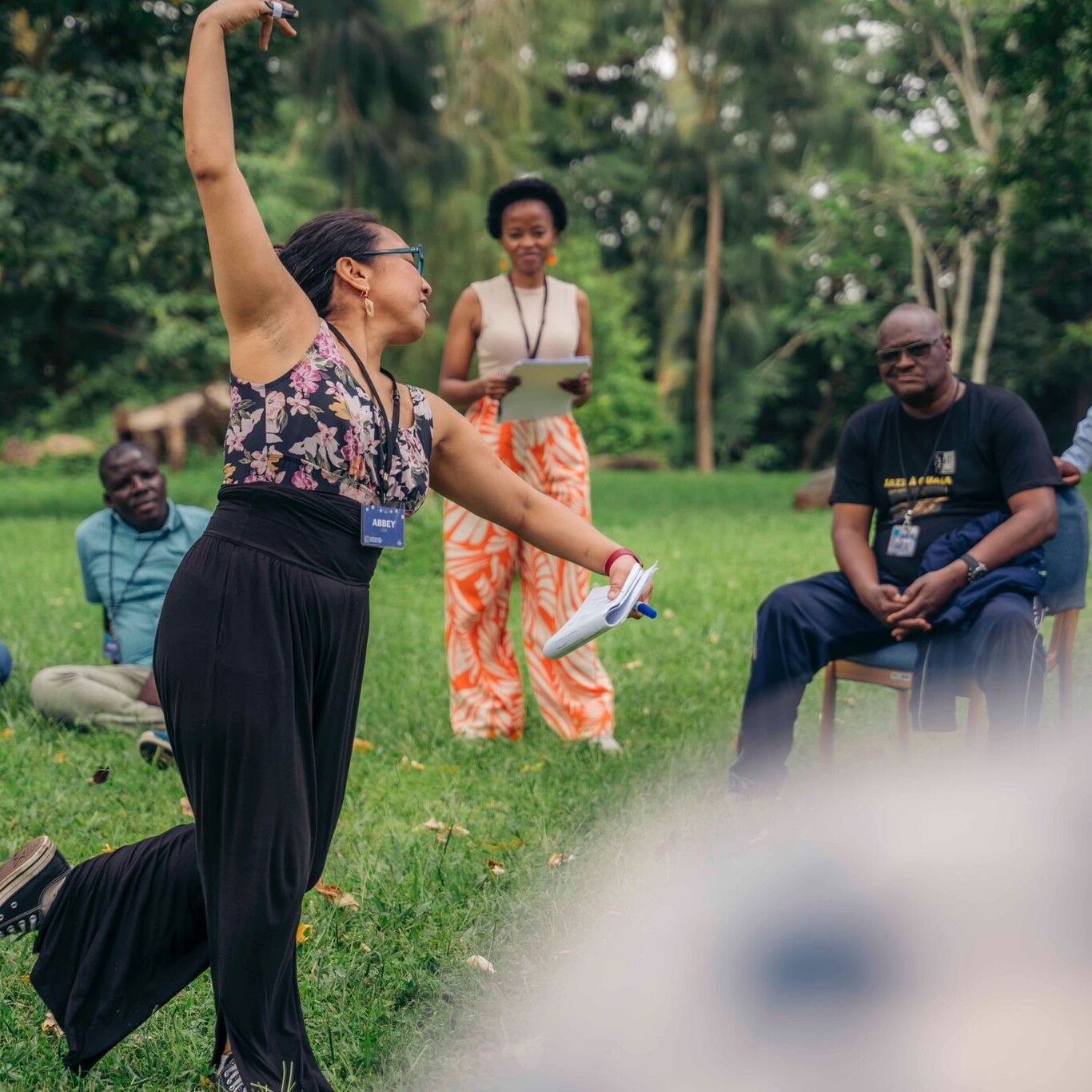A number of my writings have outlined strategies for weaving a network, but none have detailed the importance of and processes involved in building a network periphery. This blog post will guide you, step-by-step, through a process you can use with participants in your network.
First a definition. A periphery consists of people who are not part of the everyday operations of your network. Usually only a few people at most have connections to individuals in your network’s periphery.
In the drawing below, the grey dots around the outside of the network represent the periphery.
Why is spending time building a periphery so important?[ap_spacing spacing_height=”10px”]
- A periphery can provide pathways for new people to easily join your network, thus enabling your efforts to continually expand, reach new people and increase your impact. This is especially important if you have noticed that your network is disproportionately white or western, and your network wants to become more inclusive and welcoming to all.
- A periphery can connect you to other networks.
- Connections to other networks can increase your efforts to integrate and aggregate with the efforts of other networks working on the same or similar systems. For example, if you are a network working on climate change you may want to connect with other climate change networks who are trying to get new policy enacted.
- A connection to networks I call provocative networks can enable people in your network to examine their assumptions and take off blinders engendered by dominance culture. For example, many networks are connecting to anti-racism networks to help them examine and dismantle racism within their network.
- A connection to networks working on other systems can help your network stay in touch with the big picture and how other systems are impacting the system you are focusing on.
- A periphery can connect your network with others working on building the ecosystem of support needed for transformative networks:
- communications ecosystems and protocols for sharing learnings
- pools of resources restructured to support self-organizing
- pools of facilitators (network activators and catalysts, network weavers, learning weavers, culture workers, etc) that can be accessed by all networks
- learning communities
- shared resources such as handbooks, research, etc and a system for curating and creating new knowledge. [ap_spacing spacing_height=”7px”] International co-design groups are forming around these ecosystem elements, with people from several dozen networks participating in the development processes, though the resultant support ecosystem will be accessible by all networks. (Let me know if you are interested in working on this.)
- A periphery can help your network and network participants access expertise. Whether it’s organizational expertise, expertise on running an effective network, or expertise connected to your network’s purpose, your network can benefit from having connections to experts who, in many cases, might be willing to provide pro bono or lower cost services to the network or its participants.
- A periphery can help you and your network participants access new resources. Yes, we all want connections to more funders who will support our work, but there are also other kinds of resources that our networks and organizations might use that are only a step away: meeting or work space (assuming the pandemic ever ends), food, spaces for retreats, volunteers, etc.
How to assess and enhance your network’s periphery
Step 1. Inform and Recruit
- Share this blog post with as many people in your network as possible, explaining why you think this activity is important to your network and then ask people if they are interested in being part of one or two sessions to expand the network’s periphery. Be sure to explain how much time this might involve.
- Do a short virtual session on the topic ending with a call for volunteers.
Step 2. Convene
- Find several people with strong facilitation skills to help you plan and implement the session.
- Set and time and date and then send out an invitation to everyone in the network. (Using breakout sessions you should be able to easily handle many many participants so don’t worry about a huge response!). You might want to do targeted recruitment for people who have strong personal networks in each of the five areas listed above.
- Decide which of the five aspects of peripheries listed above is the highest priority for your network, as each one will take an hour or two to work on. You may decide to meet once a month for five months to work on all of them.
Step 3. The Session Process
Let’s look at the first two aspects. You can use similar processes for the rest. The key is to use a whiteboard type tool – jamboard (one of the google doc types), Miro, or the whiteboard on zoom – or even a google doc. Depending on the size of your group, you can work as a single group (if less than say 15) or move people into breakout rooms where they each work on a particular aspect. Make sure contributors give names of a contact individual, organizational name if applicable, and contact information (email probably best). In addition, it’s critical that the person who puts down a name add their name if they know the person named well enough to initiate a connection.
- A recruitment periphery. Here you are trying to build more or less permanent pathways into new communities so you can attract many more people into your network.
- Where do you want to recruit? Are you a national network who wants to bring more local groups, organizations or individuals into your community? If so, you will need to capture names and contact information for local groups that your network participants know. [ap_spacing spacing_height=”10px”] If you are trying to increase the engagement of under represented groups, you may need to spend more time doing groundwork: start by building relationships with a small number of people from those communities, making sure they find benefit from involvement in your network, especially by becoming part of projects that bring their communities more resources. Only then does it make sense to invite them to a session such as we are describing. [ap_spacing spacing_height=”15px”]
- Once you have identified key individuals and organizations, you need to work on relationships and pathways. Can you have current network participants volunteer for these organizations? Can you have listening sessions to hear what people from these communities need and discuss how the network can help them? How can your network share useful information about the network with people in these communities so they know how to pull into the network and its opportunities? Will the new groups put this information in their newsletter or share it on social media (and vice versa)? What trainings or projects are they interested in?[ap_spacing spacing_height=”15px”]
- People in your current network may work with folks in these communities on specific collaborations – and then make sure these collaboratives share back with their community on the successes (and struggles) they experienced so more people will get interested in being part of the network.
- A network of networks strategy.
- Have participants list the names and contact information for networks to which they think their network needs to be connected. Then have a go-round where people explain why they suggested that particular network. [ap_spacing spacing_height=”7px”]
- Then have participants (altogether or in breakouts) discuss how they might reach out to these networks. Some of the options you might suggest are:
- Having an introductions session where people from 3-10 networks get to know each other by sharing their role in their network, personal interests, and other personal information. [ap_spacing spacing_height=”10px”]Have each network share about their network’s strategies, priorities and projects – especially what they are open to working with others on. [ap_spacing spacing_height=”10px”]Having heard from others, each person shares what they would be interested in working from the information provided. [ap_spacing spacing_height=”10px”] Make sure there is a list of names and emails of the participants so they can contact each other after the session. [ap_spacing spacing_height=”15px”]
- Have reps from two networks meet and discuss how they might share information (from enewsletters) and follow each other on social media accounts. They might also discuss how they could support each other’s work and what opportunities they see for future collaborations. [ap_spacing spacing_height=”15px”]
- Two or more networks might have a sharing webinar for their networks where they describe current projects and future directions. Small mixed groups might discuss how the networks could work together in the future.
June Holley has been weaving networks, helping others weave networks and writing about networks for over 40 years. She is currently increasing her capacity to capture learning and innovations from the field and sharing what she discovers through blog posts, occasional virtual sessions and a forthcoming book.
featured image found here




